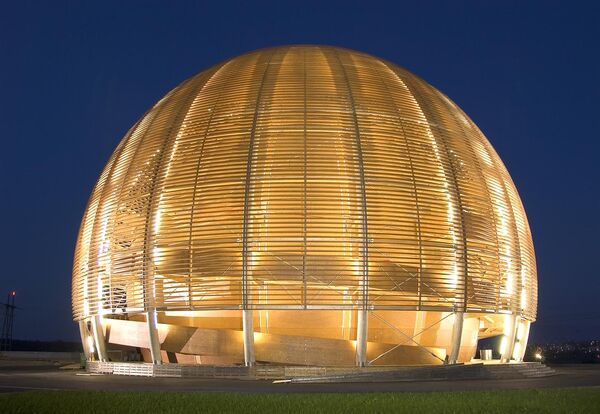MOSCOW. (Yuri Zaitsev for RIA Novosti) - Recently there have been several news announcements from the European Organization for Nuclear Research (CERN) mostly associated with the planned restart of the Large Hadron Collider (LHC), which is scheduled to power up November 19, give or take a few days.
The succession of previous unsuccessful attempts to start the collider has not hindered scientists in attempts to reproduce the so-called Big Bang in miniature. It is expected that this will help answer the question of why 90% of the blast's energy created anti-matter and only 10% matter.
Scientists also hope to be able to create particles, the existence of which has only been proven theoretically, in experimental conditions, including the so-called Higgs boson, sometimes called the "God particle." In the context of today's knowledge, this particle is responsible for the mass of elementary particles.
An important feature of the collider is the ability to simulate conditions that occur within black holes in space.
In their search for the truth, scientists are not worried about the hypothetical risk of creating microscopic black holes that could swallow surrounding matter in the accelerator tunnel.
CERN's Director General Rolf-Dieter Heuer holds that the LHC is absolutely safe, no matter how much opponents may say to the contrary. Hundreds of theoretical calculations point to there being no danger, he emphasizes.
One can only hope that these calculations are born out in practice and that the experiments in the collider do not get out of control. Still, the power of the 27-kilometer accelerator is so great that it was buried at a depth of more than 100 meters underground.
Thus far, CERN experts have completed the cooling of all eight sectors of the collider to operating temperature, which is minus 271 degrees Celsius, after which the magnets, which become superconductors in the low temperature, energized.
The strength of current will gradually increase until it reaches the values necessary to control the particle beam "traveling" through the accelerator.
Additional tests of the electrical resistance of the contacts connecting magnets are being conducted. It was specifically because of a defect in one of these contacts that an accident occurred several days after the first activation of the accelerator. As the result of a breach in the insulation of the cryogenic cooling system, six tons of liquid helium spurted into the tunnel. It took 13 months to clean up the consequences of the accident and repairs cost 40 million Swiss francs.
The collider will be restarted only at a fourth of its design capacity, which is considered to be enough to achieve the main objective of creating the most powerful accelerator in the world - detection of the Higgs boson.
After activating the system and bringing it to design capacity, it will become the most powerful high-energy accelerator of elementary particles in the world, exceeding its nearest American counterparts - the Tevatron proton-antiproton collider, located at the Fermilab in Illinois, and the Relativistic Heavy Ion Collider at the Brookhaven laboratory - by almost one order of magnitude.
It should be noted that the LHC will perform a wide range of research projects which the American colliders are simply incapable of.
The collider is expected to provide physicists with a literal avalanche of information. It is estimated that in order to record all of this information, more than two million ordinary compact discs (CDs) will be needed, and processing the information will require no fewer than 70,000 computers connected in series and with CERN.
Some experts think that the technology of building high-energy accelerators has reached its limit. Nevertheless, the International Linear Collider could be next and an even larger facility. The Joint Institute for Nuclear Research in Dubna near Moscow claims it will be able to build it. A 40-kilometer tunnel will be located 10-15 meters below the Earth's surface and its construction will be much cheaper than other proposed projects.
The costs will be distributed among organizations participating in the project. At the same time, there is be an unwritten requirement - the country hosting the internationally important facility will have to foot 35% of the bill. This will be a very sizable sum, but the construction of such a facility will be prestigious for any country.
There are other contenders besides Russia. For example, the U.S. has announced that it is willing to pay for 50% of the costs if the collider is built in the U.S.
Yuri Zaitsev is an academic adviser to the Russian Academy of Engineering Sciences.
The opinions expressed in this article are the author's and do not necessarily represent those of RIA Novosti.



